
via Getty
Shaquille O’Neal before the qualifying ahead of the Formula 1 Abu Dhabi Grand Prix at Yas Marina Circuit in Abu Dhabi, United Arab Emirates on November 19, 2022. (Photo by Jakub Porzycki/NurPhoto via Getty Images)

via Getty
Shaquille O’Neal before the qualifying ahead of the Formula 1 Abu Dhabi Grand Prix at Yas Marina Circuit in Abu Dhabi, United Arab Emirates on November 19, 2022. (Photo by Jakub Porzycki/NurPhoto via Getty Images)
What do Scoot Henderson, Dyson Daniels, and Jalen Green have in common? Well, all of them were developed by G-League Ignite. But that’s not all. In 2022, the team turned heads after signing a six-figure deal with Shaquille O’Neal’s son Shareef after a series of medical problems derailed his college career that saw him go undrafted. But it seems the tides have turned now.
On the opening day of March Madness, the NBA announced that the G League Ignite would shut down after the conclusion of the current season. The program was founded in 2020 as an alternative and offered players a chance to play a year of professional basketball in the G League post-high school instead of going to college.
Since its inception, 10 players from the G League Ignite have been drafted into the NBA. This includes top three picks Jalen Green and Scoot Henderson. Green was the No. 2 overall pick in 2021, while Henderson was the No. 3 overall pick in the 2023 draft. The G League Ignite also provided Shareef O’Neal a chance to get his career back on track after he went undrafted in the 2022 NBA draft.
ADVERTISEMENT
Article continues below this ad
Shareef O’Neal missed the first year of his journey at UCLA when he underwent open heart surgery in 2018. On his transfer to LSU, he suffered foot injuries in 2020 and 2021. He averaged 4.7 points, 3.7 rebounds, and 10.9 minutes per game playing for the Lakers in the 2022 Summer League. But it wasn’t good enough to be picked in the 2022 Draft and that is where Ignite came in.

via Getty
HENDERSON, NEVADA – OCTOBER 04: Shareef O’Neal #8 of G League Ignite looks on from the bench in the third quarter of an exhibition game against Boulogne-Levallois Metropolitans 92 at The Dollar Loan Center on October 04, 2022 in Henderson, Nevada. Ignite defeated Metropolitans 92 122-115. NOTE TO USER: User expressly acknowledges and agrees that, by downloading and or using this photograph, User is consenting to the terms and conditions of the Getty Images License Agreement. (Photo by Ethan Miller/Getty Images)
Shareef signed a reported six-figure deal with the G League Ignite in the summer of 2022. He then played 20 games in the 2022/23, averaging 5.6 points, 3.2 rebounds, and 15.5 minutes. Coming into this Ignite had an abundance of young talent at its disposal, with eight draft-eligible players for the upcoming NBA 2024 Draft. But now their future could be in limbo.
The program will play its last game on March 28 before ending its operations. One of the key factors behind this decision was the growing influence of the NCAA’s NIL policy.
NCAA boom leads to Ignite’s end
The G League Ignite was created right around the time as NIL rights were growing in the NCAA. Of course, there were proper provisions for Ignite to co-exist with the NCAA, but then fast-forward a few years, this isn’t the case anymore. The press release by the NBA stated, “The decision to end the program comes amid the changing basketball landscape, including the NCAA’s Name, Image and Likeness (NIL) policy and the advent of collectives and the transfer portal.”
ADVERTISEMENT
Article continues below this ad
The NIL deals give players a chance to be compensated before they even go pro. Even though players aren’t paid by their respective schools, they can sign deals with companies in exchange for compensation. USC’s Bronny James, son NBA icon LeBron James, is the highest-valued college athlete through NIL at $4.9 million.
Since the NIL allows players to earn money while attending college and receiving NCAA experience, many people began to opt to play for colleges and use that as a trampoline to jumpstart their NBA career. This resulted in a steep drop in recruits and an equal drop in the Ignite’s performance level, with their record at an abysmal 6-40.
During its early stages, the Ignite League became renowned for offering G-League contracts worth $100,000 to players who did not wish to participate in college basketball. However, it soon started to lose its significance over the rise of the ‘Name, Image, and Likeness (NIL) rights’, the Overtime Elite League, and other avenues. All of them provided a much better deal to the athletes in return for their time.
ADVERTISEMENT
Article continues below this ad
So, as it turns out, the NBA’s developmental league team that rescued young players like Shareef during tumultuous times in their careers could not save itself with the changing times.
ADVERTISEMENT
ADVERTISEMENT
ADVERTISEMENT
ADVERTISEMENT

